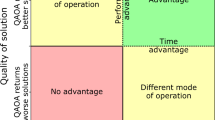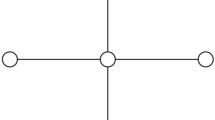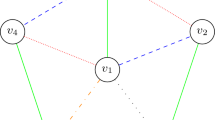Abstract
The quantum approximate optimization algorithm (QAOA) is a promising method of solving combinatorial optimization problems using quantum computing. QAOA on the MaxCut problem has been studied extensively on graphs with specific structure; however, little is known about the general performance of the algorithm on arbitrary graphs. In this paper, we investigate how different graph characteristics correlate with QAOA performance at depths at most three on the MaxCut problem for all connected non-isomorphic graphs with at most eight vertices. Some good predictors of QAOA success relate to graph symmetries, odd cycles, and density. For example, on eight vertex graphs, the average probability for selecting an optimal solution for graphs that contain no odd cycles after three iterations of QAOA is \(60.6\%\) compared to \(48.2\%\) for those that do. The data generated from these studies are shared in a publicly accessible database to serve as a benchmark for QAOA calculations and experiments. Knowing the relationship between structure and performance can be used to identify classes of combinatorial problems that are likely to exhibit a quantum advantage.








Similar content being viewed by others
References
Bravyi, S., Gosset, D., König, R.: Quantum advantage with shallow circuits. Science 362(6412), 308–311 (2018)
Riste, D., da Silva, M.P., Ryan, C.A., Cross, A.W., Córcoles, A.D., Smolin, J.A., Gambetta, J.M., Chow, J.M., Johnson, B.R.: Demonstration of quantum advantage in machine learning. Quant. Inf. 3(1), 1–5 (2017)
Farhi, E., Goldstone, J., Gutmann, S.: A quantum approximate optimization algorithm. arXiv preprint arXiv:1411.4028, (2014)
Farhi, E., Gamarnik, D., Gutmann, S.: The quantum approximate optimization algorithm needs to see the whole graph: Worst case examples. arXiv preprint arXiv:2005.08747, (2020)
Conforti, M., Cornuéjols, G., Zambelli, G., et al.: Integer programming. Springer, Berlin (2014)
Festa, P., Pardalos, P.M., Resende, M.G.C., Ribeiro, C.C.: Randomized heuristics for the MAX-CUT problem. Optim. Methods Softw. 17(6), 1033–1058 (2002)
Goemans, M.X., Williamson, D.P: 879-approximation algorithms for max cut and max 2sat. In Proceedings of the twenty-sixth annual ACM symposium on theory of computing, pages 422–431, (1994)
Brandão, F. G. S. L., Broughton, M., Farhi, E., Gutmann, S., Neven, H.: For fixed control parameters the quantum approximate optimization algorithm’s objective function value concentrates for typical instances. arXiv preprint arXiv:1812.04170, (2018)
Medvidović, M., Carleo, G.: Classical variational simulation of the quantum approximate optimization algorithm. arXiv preprint arXiv:2009:01760v1, (2020)
Zhou, L., Wang, S.-T., Choi, S., Pichler, H., Lukin, M. D.: Quantum approximate optimization algorithm: performance, mechanism, and implementation on near-term devices. arXiv preprint arXiv:1812.01041, (2018)
Akshay, V., Philathong, H., Zacharov, I., Biamonte, J.: Reachability deficits implicit in google’s quantum approximate optimization of graph problems. arXiv preprint arXiv:2007.09148, (2020)
Farhi, E., Gamarnik, D., Gutmann, S.: The quantum approximate optimization algorithm needs to see the whole graph: a typical case. arXiv preprint arXiv:2004.09002, (2020)
Ozaeta, A., van Dam, W., McMahon, P. L.: Expectation values from the single-layer quantum approximate optimization algorithm on ising problems. arXiv preprint arXiv:2012.03421, (2020)
Lotshaw, P. C., Humble, T. S., Herrman, R., Ostrowski, J., Siopsis, G.: Empirical performance bounds for quantum approximate optimization. arXiv preprint arXiv:2102.06813, (2021)
Belotti, P.: Couenne: a user’s manual. Technical report, Technical report, Lehigh University, (2009)
Press, W. H., Flannery, B. P., Teukolsky, S. A.: Numerical recipes in Fortran 77: the art of scientific computing. Cambridge University Press, second edition, (1993). https://people.sc.fsu.edu/~inavon/5420a/DFP.pdf
Lotshaw, P. C., Humble, T. S.: QAOA dataset. Found at https://code.ornl.gov/qci/qaoa-dataset-version1
McKay, B.: Graphs [data set]. Found at http://users.cecs.anu.edu.au/~bdm/data/graphs.html
Shaydulin, R., Hadfield, S., Hogg, T., Safro, I.: Classical symmetries and QAOA. arXiv preprint arXiv:2012.04713, (2020)
Wurtz, J., Love, P. J: Bounds on MAXCUT QAOA performance for p\({>}\) 1. arXiv preprint arXiv:2010.11209, (2020)
Herrman, R., Ostrowski, J., Humble, T.S., Siopsis, G.: Lower bounds on circuit depth of the quantum approximate optimization algorithm. Quant. Inf. Process. 20(59), 1 (2021)
Acknowledgements
The authors would like to thank Ryan Bennink for his helpful comments on early drafts of this manuscript. This work was supported by DARPA ONISQ program under Award W911NF-20-2-0051. J. Ostrowski acknowledges the Air Force Office of Scientific Research Award, AF-FA9550-19-1-0147. G. Siopsis acknowledges the Army Research Office Award W911NF-19-1-0397. J. Ostrowski and G. Siopsis acknowledge the National Science Foundation Award OMA-1937008. This manuscript has been authored by UT-Battelle, LLC under Contract No. DE-AC05-00OR22725 with the US Department of Energy. The United States Government retains and the publisher, by accepting the article for publication, acknowledges that the United States Government retains a non-exclusive, paid-up, irrevocable, world-wide license to publish or reproduce the published form of this manuscript, or allow others to do so, for United States Government purposes. The Department of Energy will provide public access to these results of federally sponsored research in accordance with the DOE Public Access Plan. (http://energy.gov/downloads/doe-public-access-plan).
Author information
Authors and Affiliations
Corresponding author
Additional information
Publisher's Note
Springer Nature remains neutral with regard to jurisdictional claims in published maps and institutional affiliations.
Appendix
Appendix
1.1 Appendix A: graph theory definitions
In this section, we define some of the less common graph theory terms that appear in the paper.
Definition A.1
(Diameter) The diameter of a graph \(G=(V,E)\) is \(\max _{u,v} d(u,v)\), where d(u, v) denotes the distance between \(u, v \in V\).
Definition A.2
(Distance) The distance between two vertices, u and v, of a graph \(G=(V,E)\) is the number of edges in the shortest path between u and v.
Definition A.3
(Clique number) The clique number of a graph is the size of the largest complete subgraph.
Definition A.4
(Bipartite) A graph is bipartite if the vertices can be partitioned into two sets such that all edges are incident to a vertex in both sets.
Definition A.5
(Eulerian cycle) An Eulerian cycle is a cycle that uses all edges of a graph exactly once.
Definition A.6
(Eulerian) A graph is Eulerian if it is connected and contains an Eulerian cycle.
Definition A.7
(Distance Regular) A graph \(G=(V,E)\) is distance regular if for any pair of vertices \(x,y \in V\), the number of vertices that are distance i from x equals the number of vertices that are distance i from y, for \(i \in \{1, 2, ..., d\}\), where d is the diameter of G.
Definition A.8
(Cut vertex) A cut vertex of a connected graph is a vertex whose removal disconnects the graph.
Definition A.9
(Graph Automorphism) A graph automorphism is a relabeling of vertices that preserves the set of edges. Mathematically, it is a map \(\alpha : V \longrightarrow V\) such that \(ij \in E\) if and only if \(\alpha (i)\alpha (j) \in E\).
Definition A.10
(Automorphism Group) The set of all graph automorphisms of G forms an automorphism group of G.
Definition A.11
(Group Size) The group size of G is the size of the automorphism group of G.
Definition A.12
(Orbit) An orbit of a vertex v is the set of all vertices \(\alpha (v)\) where \(\alpha \) is an automorphism of G.
1.2 Appendix B: database details
The data generated from these studies are shared in a publicly accessible GitHub Repository to serve as a benchmark QAOA calculations and experiments. This data set consists of csv files for each set of graphs on n vertices for \(3 \le n \le 8\). The generated graph entries, which populate each set, are indexed by a graph number and include the following properties: bipartite (Boolean), number of edges, diameter, clique number, distance regular (Boolean), Eulerian (Boolean), list of cut vertices, number of cut vertices, cycle basis, degree sequence, automorphism group generator, automorphism group size, orbits, number of orbits, and the number of small cycles on 3 to n vertices. In addition to the data set, we have provided two options for storing and sorting this data by desired graph properties. The first option is to insert the data into a MySQL database structure. The user can then query the database to select the desired data and insert new columns for additional properties, calculations, and experimental results. We have provided scripts for creating the database tables, populating the tables using the csv files, querying the database, and inserting new columns. For additional information on how to download and use MySQL, see the MySQL Documentation.To work with the data set directly, we have also included a Python script which utilizes the data analysis library pandas. Pandas is a library which allows the user to store and manipulate data in two-dimensional, labeled data structures called DataFrames. We have provided a Python script which allows the user to import the csv data into pandas DataFrames and create new DataFrames with the desired graph properties. For more information on how to use and install pandas, see the Pandas Documentation. Both MySQL and Pandas are free, open-source software packages. This data set, the MySQL Scripts, and Python script can be accessed through the QAOA Small Graph GitHub Repository.
1.3 Appendix C: data tables
In this section, we include the tables containing all correlations between different graph properties and metrics. For the Boolean properties, we assign “1” to TRUE and “0” to FALSE. See Tables 4, 5, 6, 7, 8, and 9.
Rights and permissions
About this article
Cite this article
Herrman, R., Treffert, L., Ostrowski, J. et al. Impact of graph structures for QAOA on MaxCut. Quantum Inf Process 20, 289 (2021). https://doi.org/10.1007/s11128-021-03232-8
Received:
Accepted:
Published:
DOI: https://doi.org/10.1007/s11128-021-03232-8




